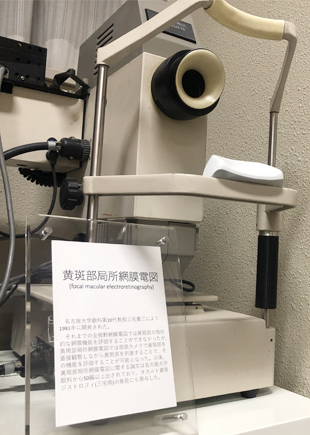Department of Ophthalmology
Nagoya University Graduate School of Medicine

Welcome
Department of Ophthalmology, Nagoya University Graduate School of Medicine was established in 1882. Since then, many members of the department have made notable contributions mainly in the field of retina and ocular surgery.
Selected achievements includes;
1906, Discovery of Oguchi Disease (Professor Chuta Oguchi)
1980, Invention of Ando plombe (Dr Fumitaka Ando)
1981, 1989 Invention of focal macular ERG and discovery of occult macular dystrophy (Professor Yozo Miyake)
1998, Use of ICG for staining of the anterior capsule (Professor Masayuki Horiguchi)
Three main goals of the department are as follows;
1. Establishment of a cutting-edge clinical center
Diagnosis and treatment of ocular diseases are becoming increasingly complex and the demands for highly specialized personnel that can deliver updated high quality medical services to patients are increasing. We strive to make full use of both established standard care and cutting-edge medical approach to provide the best service for each patient.
2. Innovation in ophthalmology practice through research
The goal of our research is to solve important clinical questions encountered through daily clinical practice. We aim to achieve this through innovations in medical practice by the development of diagnostic methods and treatments. We support all team members who earnestly engage in research.
3. Developing a team with diverse abilities
We aim to create a highly flexible work environment in which medical staff can advance toward individual goals through their medical and research activities. In addition, in order to foster members with diverse abilities, we encourage our staffs and trainees to take on the challenge of studying in a nationally or globally diverse setting.

Focal macular ERG
Staff
Koji M Nishiguchi Professor and Chairman
Professor and Chairman, Department of Ophthalmology, Nagoya University Graduate School of Medicine, Japan
E-mail: kmn@med.nagoya-u.ac.jp
- CLINICAL INTEREST
- ・Inherited retinal dystrophy
・Intraocular inflammation
・Vitreoretinal surgery - RESEARCH INTEREST
- ・Development of new gene therapies for ocular diseases (i.e., inherited retinal dystrophy)
・Multi-omics diagnosis of ocular diseases
・Structure-function relationship in retinal diseases - TRAINING & EMPLOYMENTS
- 1999-2005 Resident in Ophthalmology, Nagoya University Hospital, Japan
2000-2001 Research Fellow, Schepens Eye research Institute, USA
2002-2004 Research Fellow, Massachusetts Eye and Ear Infirmary, USA
2007-2011 Assistant Professor of Ophthalmology, Nagoya University Hospital, Japan
2011 Research Fellow, University of Lausanne, Switzerland
2012-2013 Clinical research associate, UCL Institute of Ophthalmology, UK
2014-2020 Associate Professor, Advanced Ophthalmic Medicine, Tohoku University Graduate School of Medicine, Japan
2020~ Professor & Chairman, Department of Ophthalmology, Nagoya University Graduate School of Medicine, Japan - SELECTED PUBLICATIONS
- 1. Nishiguchi KM, Fujita K, Miya F, Katayama S, Nakazawa T. Single AAV-mediated mutation replacement genome editing in limited number of photoreceptors restores vision in mice. Nat Commun. 2020;11(1):482.
2. Nishiguchi KM, Ikeda Y, Fujita K, Kunikata H, Akiho M, Hashimoto K, Hosono K, Kurata K, Koyanagi Y, Akiyama M, Suzuki T, Kawasaki R, Wada Y, Hotta Y, Sonoda KH, Murakami A, Nakazawa M, Nakazawa T, Abe T : Phenotypic Features of Oguchi Disease and Retinitis Pigmentosa in Patients with S-Antigen Mutations: A Long-Term Follow-up Study. Ophthalmology 126 : 1557-1566, 2019.
3. Nishiguchi KM, Fujita K, Tokashiki N, Komamura H, Takemoto-Kimura S, Okuno H, Bito H, Nakazawa T : Retained Plasticity and Substantial Recovery of Rod-Mediated Visual Acuity at the Visual Cortex in Blind Adult Mice with Retinal Dystrophy. Mol Ther 26 : 2397-2406, 2018.
4. Nishiguchi KM, Carvalho LS, Rizzi M, Powell K, Holthaus SM, Azam SA, Duran Y, Ribeiro J, Luhmann UF, Bainbridge JW, Smith AJ, Ali RR : Gene therapy restores vision in rd1 mice after removal of a confounding mutation in Gpr179. Nature Commun 6 : 6006, 2015.
5. Nishiguchi KM, Tearle RG, Liu YP, Oh EC, Miyake N, Benaglio P, Harper S, Koskiniemi-Kuendig H, Venturini G, Sharon D, Koenekoop RK, Nakamura M, Kondo M, Ueno S, Yasuma TR, Beckmann JS, Ikegawa S, Matsumoto N, Terasaki H, Berson EL, Katsanis N, Rivolta C : Whole genome sequencing in patients with retinitis pigmentosa reveals pathogenic DNA structural changes and NEK2 as a new disease gene. Proc Natl Acad Sci U S A 110 : 16139-16144, 2013.
6. Nishiguchi KM, Friedman JS, Sandberg MA, Swaroop A, Berson EL, Dryja TP : Recessive NRL mutations in patients with clumped pigmentary retinal degeneration and relative preservation of blue cone function. Proc Natl Acad Sci U S A 101 : 17819-24, 2004.
7. Nishiguchi KM, Sandberg MA, Kooijman AC, Martemyanov KA, Pott JW, Hagstrom SA, Arshavsky VY, Berson EL, Dryja TP : Defects in RGS9 or its anchor protein R9AP in patients with slow photoreceptor deactivation. Nature 427 : 75-78, 2004. - kmn@med.nagoya-u.ac.jp
Hiroki Kaneko Associate Professor
- SUBSPECIALITY
- Vitreoretinal surgery, diabetic retinopathy
- RESEARCH INTEREST
- Pathophysiological analysis and the development of new therapeutic methods for intractable retinal diseases
- Message
- I am looking for physicians who are good with the hands to work with me as ophthalmologists.
Kenya Yuki Lecture
- SUBSPECIALITY
- Glaucoma
- CLINICAL and RESEARCH INTEREST
- Glaucoma surgery, Risk factor for glaucoma onset and progression
Kosuke Fujita Assistant Professor
- RESEARCH INTEREST
- ・Development of new gene therapies for ocular diseases (i.e., inherited retinal dystrophy)
Hiroaki Ushida Assistant Professor
- CLINICAL INTEREST
- ・uveitis
・vitreoretinal surgery
・vitreoretinal disease - RESEARCH INTEREST
- Establishment of a new diagnostic method for uveitis with unknown cause
Improving the diagnostic rate of vitreoretinal lymphoma
Norie Nonobe Assistant Professor
- CLINICAL INTEREST
- ・pediatric retina
・Vitreoretinal surgery
Taro Kominami Assistant Professor
- CLINICAL INTEREST
- ・Inherited retinal disease
・Vitreoretinal surgery - RESEARCH INTEREST
- ・Electrophysiology in retinal diseases
・Structure-function relationship in inherited retinal diseases
・Artificial Intelligence(machine learning)
Yoshito Koyanagi Assistant Professor
- CLINICAL INTEREST
-
・Inherited retinal dystrophy
・Intraocular inflammation
・Ophthalmic surgery - RESEARCH INTEREST
- ・DNA sequencing and genetic diagnosis
・Data analysis and storage
・Digital transformation
・Society 5.0
Ayana Suzumura Assistant Professor
- CLINICAL INTEREST
- ・Diabetic retinopathy
・Retinal vein occlusion
・Uveitis - RESEARCH INTEREST
- ・Development of new therapies for diabetic retinopathy
・Elucidation and improvement of neuroretinal dysfunction
Ota Hikaru Assistant Professor
- CLINICAL INTEREST
- ・Medical retina
・Vitreoretinal surgery - RESEARCH INTEREST
- ・Macular Disease
・Structure-function relationship in retinal disease
Research Team
Applied Genetics Team
Our goal
Through translational research, we aim to elucidate of the pathogenesis of ocular diseases through multi-omics analysis of human samples and development of novel gene therapy for retinal diseases and glaucoma.
Our research
We are focused on developing novel gene therapy for inherited retinal degeneration and other ocular disease, with specific attention to genome editing technology using patient-derived cells and specimen, mice, and monkeys.
We also explore pathogenesis of ocular diseases using cutting-edge multi-omics analysis with the aim of finding therapeutic target and clinically useful biomarkers.
Our achievement
Nishiguchi KM, Miya F, Mori Y, Fujita K et al., A hypomorphic variant in EYS detected by genome-wide association study contributes toward retinitis pigmentosa. Commun Biol. 2021;4(1):140.
Nishiguchi KM, Fujita K et al., Single AAV-mediated mutation replacement genome editing in limited number of photoreceptors restores vision in mice. Nat Commun. 2020;11(1):482.
Nishiguchi KM, Fujita K et al., Retained Plasticity and Substantial Recovery of Rod-Mediated Visual Acuity at the Visual Cortex in Blind Adult Mice with Retinal Dystrophy. Mol Ther. 2018;26(10):2397-2406.
Fujita K, Nishiguchi KM et al., Spatially and Temporally Regulated NRF2 Gene Therapy Using Mcp-1 Promoter in Retinal Ganglion Cell Injury. Mol Ther Methods Clin Dev. 2017;5:130-141.
Core member
Koji Nishiguchi M.D., Ph.D., FRCOphth.
Professor and Chairman
Kosuke Fujita, Ph.D.
Assistant Professor and Lab manager
Recruitment
We welcome application of motivated graduate students or post-docs who have basic skills & experience in molecular biology/genetics and are self-funded. Please note that since we are a small research team, we can accommodate only few applicants annually.
Please send an email to Dr Fujita for a query <お問い合わせフォーム>
Reverse Translational Research Team
Our group has been conducting reverse translational research to solve clinical problems by applying basic research methods using samples such as vitreous humor and anterior chamber aqueous humor from patients, based on the unique viewpoint of clinicians on the symptoms and problems of retinal diseases.
We have reported that histamine H4 receptors, which are allergy-related, are expressed in choroidal neovascularization in age-related macular degeneration and may be a potential new therapeutic target. We have also reported that the metabolite 18-HEPE specifically acts on Müller glial cells in the retina by oral administration of eicosapentaenoic acid (EPA), an ω3 fatty acid, and it may treat the functional impairment of neuroretinal cells seen in early diabetes via brain-derived trophic factor (BDNF).
In addition, we are conducting multifaceted research on retinal diseases, such as proposing a new concept of retinal disorders by elucidating the pathogenesis of silicone oil-related vision loss (SORVL).
Glaucoma Team
Glaucoma is the leading cause of blindness in Japan.
Therefore, new findings on glaucoma are needed to provide better medical care.
The glaucoma research group is researching visual function and structure relationships in glaucoma patients, the quality of life of the glaucoma patients, and glaucoma surgery. Our accomplishments will be presented at national and international conferences and academic journals.
Macular Disease Team
We are engaged in clinical research using OCT/OCTA imaging and aqueous humor cytokine profiling for macular diseases such as age-related macular degeneration and pachychoroid diseases. Taking advantage of the abundant number of cases at Nagoya university hospital, we are working to elucidate the pathophysiology of macular diseases and to build evidence that will be directly relevant to tomorrow’s practice.
Uveitis Team
About 30-40% of patients with uveitis have unknown causes. Our goal is to elucidate the causes of these diseases and to create new examination methods by applying molecular biological techniques.
In addition, we aim to improve the diagnostic rate of vitreoretinal lymphoma, which is difficult to diagnose.
AI Team
AI has made remarkable progress in recent years with the big data and the development of computer resource. AI is also spreading in the field of ophthalmology. We try to apply machine learning techniques to assessing progression of retinal diseases.



